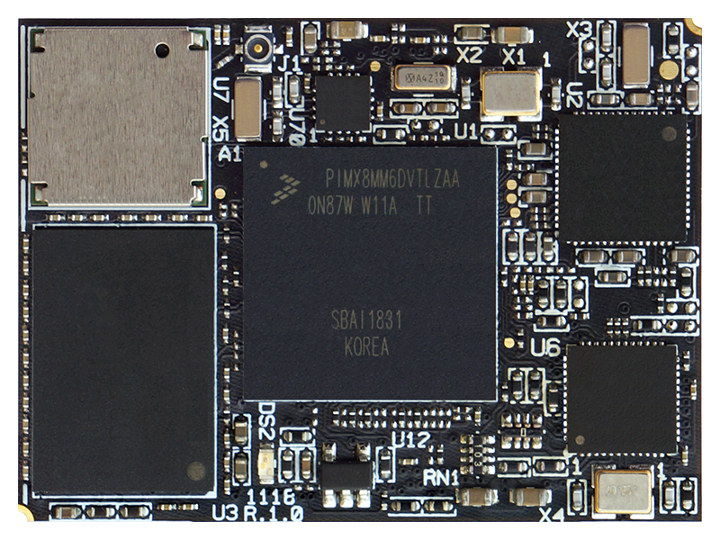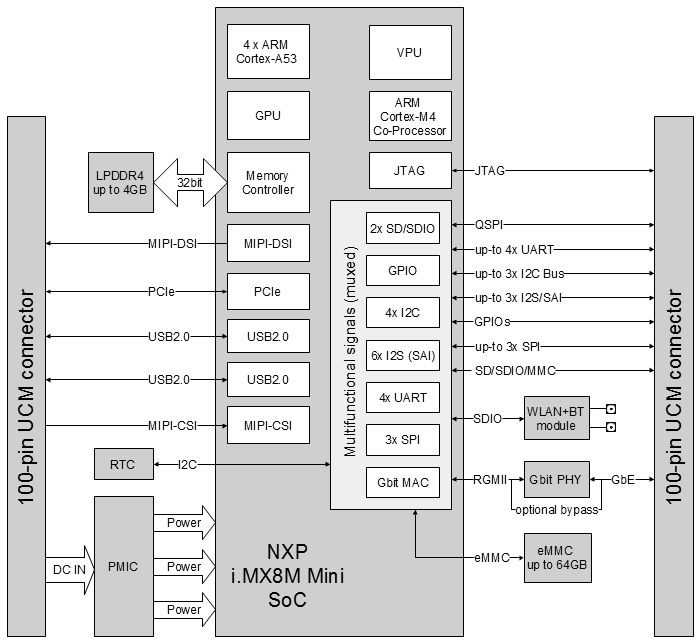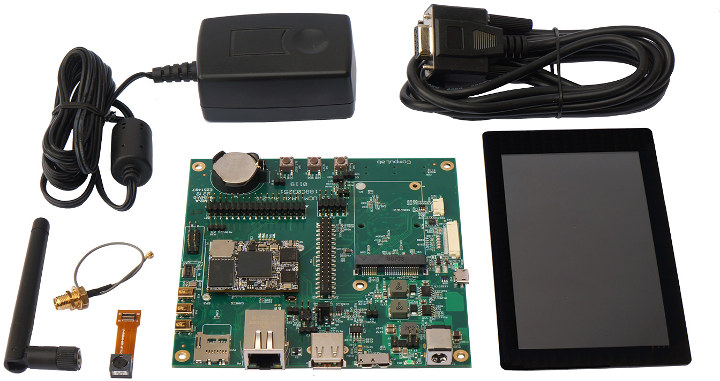We’ve recently written about several new hardware platforms based on the latest NXP i.MX 8M Mini processor family including Nitrogen8M_Mini SBC and F&S Elektronik PicoCore MX8MM SoM. Thanks to a new 14-nm process, the new family has the advantage of consuming less power, and the Cortex-A53 cores can run at a higher frequency. They should cost less as well thanks to cost-saving measures like the adoption of a 1080p video decoder instead of a 4K decoder found in the older NXP i.MX 8M family.
CompuLab has now launched their own NXP i.MX 8M Mini SoM with UCM-iMX8M-Mini module that’s about the size of a largish stamp (38 x 28 mm) suitable for portable and space constrained applications such as professional handheld devices, wearable healthcare monitors and medical devices, autonomous drones with visual object recognition, or portable instrumentation equipment with advanced HMI.
 CompuLab UCM-iMX8M-Mini SoM specifications:
CompuLab UCM-iMX8M-Mini SoM specifications:
- SoC (one or the other)
- NXP i.MX8M Mini Quad Arm Cortex-A53 processor @ 1.8GHz, Arm Cortex-M4F real-time core, GC NanoUltra 3D GPU, GC320 2D GPU, 1080p60 H.265, H.264, VP9 and VP8 decode, and 1080p60 H.264 and VP8 encode.
- NXP i.MX8M Mini Dual Arm Cortex-A53 processor @ 1.8GHz, Arm Cortex-M4F real-time core, GC NanoUltra 3D GPU, GC320 2D GPU, 1080p60 H.265, H.264, VP9 and VP8 decode, and 1080p60 H.264 and VP8 encode.
- NXP i.MX8M Mini DualLite Arm Cortex-A53 processor @ 1.8GHz, , Arm Cortex-M4F real-time core, GC NanoUltra 3D GPU, GC320 2D GPU, no video processing unit.
- System Memory – Up to 4GB LPDDR4 RAM
- Storage – Up to 64GB of on-board eMMC flash
- Networking
- On-board Gigabit Ethernet PHY
- Wireless module with Dual-band WiFi 802.11ac, Bluetooth 4.2 BLE
- 2x 100-pin board to board connectors (0.4mm pitch) exposing
- 1x MMC/SD/SDIO interface
- Display
- 4- lane MIPI-DSI up to 1920 x 1080 @ 60Hz
- Touchscreen capacitive touch-screen support through SPI and I2C interfaces
- Camera I/F – 4-lane MIPI-CSI interface
- Audio – Up to 3x I2S / SAI
- USB – 2x USB2.0 dual-role ports
- PCI – PCIe x1 Gen. 2.1
- UART – Up to 4x UART ports
- General I/O – Up to 3x I2C, 3x SPI, 4x PWM, 85x GPIO
- Supply Voltage – 3.45V to 4.4V
- Dimensions – 38 x 28 x 4 mm
- Weight – 7 grams
- Temperature Range – -40 to 85°C

The company provides Linux and Android BSP’s and firmware images with Linux kernel 4.14, Yocto Project file-system (for Linux), and U-Boot bootloader.
To quickly get started with evaluation and early software development, SB-UCMIMX8 carrier board and EVAL-UCM-iMX8M evaluation kit are provided.
SB-UCMIMX8 carrier-board key features:
- Board-to-board sockets for UCM-iMX8M-Mini SoM
- Storage – Micro SD card socket
- Display and Camera
- LCD panel – MIPI-DSI interface, up to 1920×1080, FPC connector; capacitive touch-screen interface, FPC connector; gully supports Startec KD050HDFIA020 5″ 1280×720 LCD panel
- Camera – MIPI CSI, 2×12 B2B connector; compatible with LI-OV5640-MIPI-AF camera module
- Network
- 1000/100/10Mbps Ethernet port, RJ45 connector
- 802.11a/b/g/n/ac WiFi 5 + Bluetooth 4.2 BLE (Broadcom BCM43353 chipset)
- Cellular – Support for cellular modem via mini-PCie socket, on-board micro-SIM card socket
- Audio
- Analog Audio – Analog stereo output, line-in, 3.5mm jacks implemented with the CL-SOM-iMX8 audio codec
- Digital Audio – S/PDIF input/output, 3.5mm jacks
- USB – 1x USB2.0 host, type-A connector, 1x USB2.0 OTG, micro-USB connector
- Serial
- 1x serial debug port via UART-to-USB bridge, micro-USB connector
- 1x serial debug port via RS232 transceiver, ultra-mini serial connector (mutually exclusive with serial debug port via USB)
- Up-to 2x UART, 3.3V levels, 100-mil header
- Expansion
- mini-PCIe socket, full-size
- 100-mil I/O headers with up to 1x SPI interface, up-to 2x I2C interfaces, up-to 34x GPIO’s, JTAG
- Misc – RTC + coin-cell battery
- Supply Voltage – Unregulated 8V to 18V
- Digital I/O voltage – 3.3V
- Dimensions – 118 x 118 x 22 mm
- Weight – 125 grams

EVAL-UCM-iMX8M evaluation kit includes one UCM-iMX8M-Mini SoM, one SB-UCMIMX8 carrier board, a 5” WXGA LCD panel, a 5MP camera module, a power supply, cables and a technical support contract.
UCM-iMX8M-Mini is available now starting at $54 for volume orders (1k +) in minimum configuration, while EVAL-UCM-iMX8M evaluation kit is offered for $385. More information about the SoM, devkit and detailed options prices can be found in the product page.

Jean-Luc started CNX Software in 2010 as a part-time endeavor, before quitting his job as a software engineering manager, and starting to write daily news, and reviews full time later in 2011.
Support CNX Software! Donate via cryptocurrencies, become a Patron on Patreon, or purchase goods on Amazon or Aliexpress




